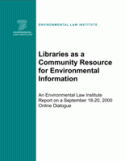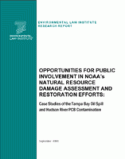
Research Reports
ELI publishes Research Reports available for free download that present the analysis and conclusions of the policy studies ELI undertakes to improve environmental law and policy. These reports contribute to education of the profession and disseminate diverse points of view and opinions to stimulate a robust and creative exchange of ideas. Those publications, which express opinions of the authors and not necessarily those of the Institute, its Board of Directors, or funding organizations, exemplify ELI’s commitment to dialogue with all sectors.
Following the 1999 study, ELI began work on the second phase of its research which focused on whether a collaboration between EPA and the public libraries could serve to increase capacity of communities to participate in EPA activities.
Read More >
This study examines two NRDA cases -- contamination of the Hudson River with polychlorinated biphenyls (PCBs) and the 1993 Tampa Bay oil spill -- and identifies public participation strategies that DAC may choose to implement for future NRDA efforts.
Read More >This article, which originally appeared in the July 21, 2000, issue of Environment Reporter, examines the current "end-of-pipe" methods of reducing NOx emissions and suggests that a better method would be investing in new, combined cycle natural gas plants, cogeneration and efficiency gains. The second approach would not only reduce NOx emissions but other pollutants as well.
Read More >
Paying landowners not to pollute, providing free technical advice, and relying on voluntary adherence to BMPs has proven to be an incomplete strategy in many cases. Gradually, states are turning to enforceable mechanisms – including discharge prohibitions, direct enforcement of water quality standards, pollution abatement orders, required operating practices, nuisance and misdemeanor prosecutions, and civil and administrative penalties -- to supplement other approaches.
Read More >The Chesapeake Bay region has experienced significant growth during the past 30 years and continues to grow at a rapid rate. The population of the region increased 26 percent between 1970 and 1994 and is now expected to increase by an additional 3 million people by the year 2020. The resulting demand for new development, often low-density and single-use, has led to a significant loss of open land and the emergence of new pollution concerns.
Read More >